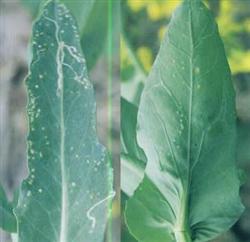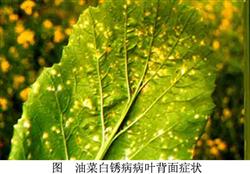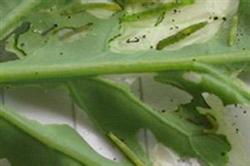Integrated control techniques of rape white rust

The white rust pathogen of rape is white rust, which is a common disease on rape and cruciferous vegetables in the Yangtze River Basin. It often coexists with downy mildew of rape on the same flower axis. 1. Symptoms: All organs of rape in the whole growth period can be infected. Light green spots appear on the surface of leaves, then yellow round spots appear, white lacquer blisters appear on the back of leaves, and white powder is released after the blisters rupture. When the disease is severe, the leaves will wither and fall off. Young stems and pedicels swollen after suffering, curved into a "dragon head" shape, commonly known as "dragon head disease." The flower organ is damaged, the petals are deformed, expanded, green and leafy, and do not wither for a long time. The affected stems, branches, pedicels, flower organs and siliques can all grow oblong or short strip blisters and white mold layers. 2. Transmission route: ospores oversummer or overwinter in diseased plants, soil and seeds. 3. Pathogenesis rule: sporangia are produced on the disease spots, which are transmitted by wind and rain to cause reinfection. In winter, ospores or hyphae overwintered in the diseased plants, and in the following year, a large number of sporangia were produced in the diseased plants to spread again. 4. Control methods: ① Select disease-resistant varieties. Brassica juncea had the strongest resistance, followed by Brassica napus, and Brassica campestris was susceptible. There are many varieties of high resistance, can be selected according to local conditions. (2) selecting disease-free plants for seed reservation or seed treatment. (3) Cultivate for disease prevention. The disease prevention measures include rotation of paddy and upland crops or rotation with non-cruciferous crops, rational fertilization, sufficient basal fertilizer, heavy seedling fertilizer, removal of old and diseased leaves and "dragon head", deep groove and narrow ridge, prevention of waterlogging, etc. ④ Chemical control. Spray at 17~33 cm height or at the beginning of flowering, when there are more diseases on short stalk leaves. 600 - 800 times solution of 25% ridoxycycline wettable powder, 500 times solution of 80% phosphoethyl aluminum wettable powder, 1000 - 1500 times solution of 50% thiophanate wettable powder, 1000 times solution of 50% tuijunte wettable powder and 500 times solution of 65% manineb wettable powder are selected, spraying is started when the leaf disease plant rate is more than 10% at the initial flowering stage, spraying is carried out once every 7 days, spraying is carried out for 2 - 3 times, and spraying is carried out for 50 kilograms per mu each time.
- Prev

When transplanting rape board stubble, we should take care of the five hurdles.
1. Characteristics of symptoms. Rape white rust mainly affects leaves, stems, pedicels and floral organs. The symptoms on leaves and stems are characterized by blister spots. The blister face is white or milky white, slightly raised, small (ranging from 1 to 3 mm), with a large number of white powdery matter (symptoms) after rupture, resulting in leaf withering and early falling. ...
- Next

Field management measures of wheat and rape during overwintering period
The diamondback moth (Plutella xylostella) is one of the main pests on rapeseed. Rape can produce 3-4 generations in a lifetime in central Jiangsu, and the generations overlap. The damage peak is when the temperature rises above 12 ℃ (March-April). When rape seedlings have 8 leaves and 10 leaves, field inspection should be paid attention to. When there are more than 20 larvae per square meter, drug control should be used immediately.
Related
- The first cup of black tea in spring, the flavor and history of tea gardens in Kenya, Africa
- The computer can not only choose potatoes, but also grow tea rice. AI will grow winter oolong tea champion.
- It is not only the inflated tea bitten by insects, but also engraved with the four seasons tea in Beipu.
- The Oriental Beauty Tea Festival in Zhuxian County takes the stage at the weekend to experience the plus-size feast of oil tea.
- & quot; Oriental Beauty Tea & Exploration of Emei in Hsinchu, the hometown of quot;
- The new variety of strawberry "Tainong 1" dessert is the first choice with mellow aroma. Crimson gorgeous
- History of Tea in Taiwan: from Wild Inner Mountain to Export Tea Garden
- Two types of Taiwan Oriental Beauty Black Tea won the British three-Star Award for Childhood Tea Xiang Zhang Jiaqi changed from pilot to champion tea maker.
- Banana species and varieties: the planting history of Taiwan Xianren banana and dwarf banana is long, is banana disease resistant?
- Coffee planting Technology: Qianjie Coffee from Seedling to harvesting

